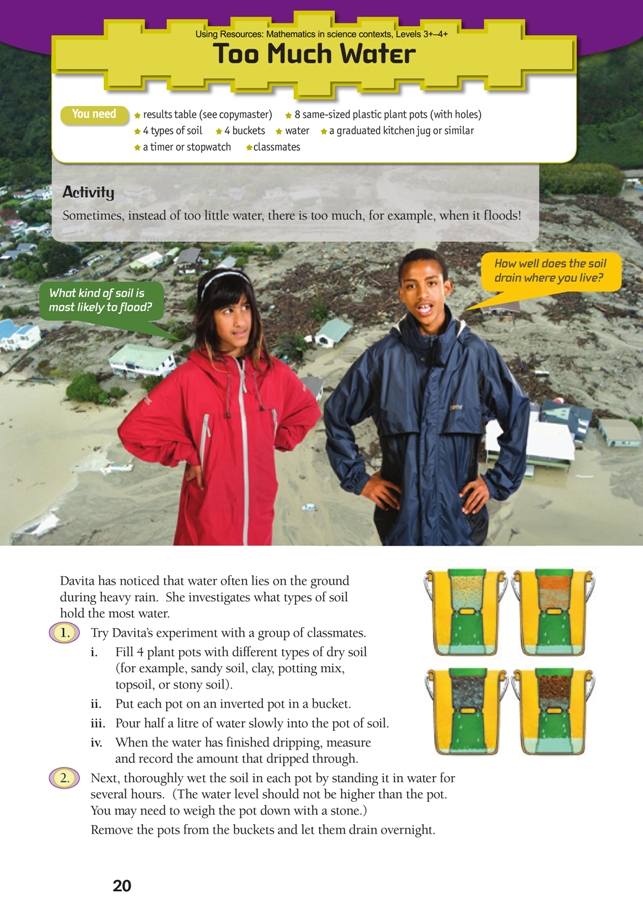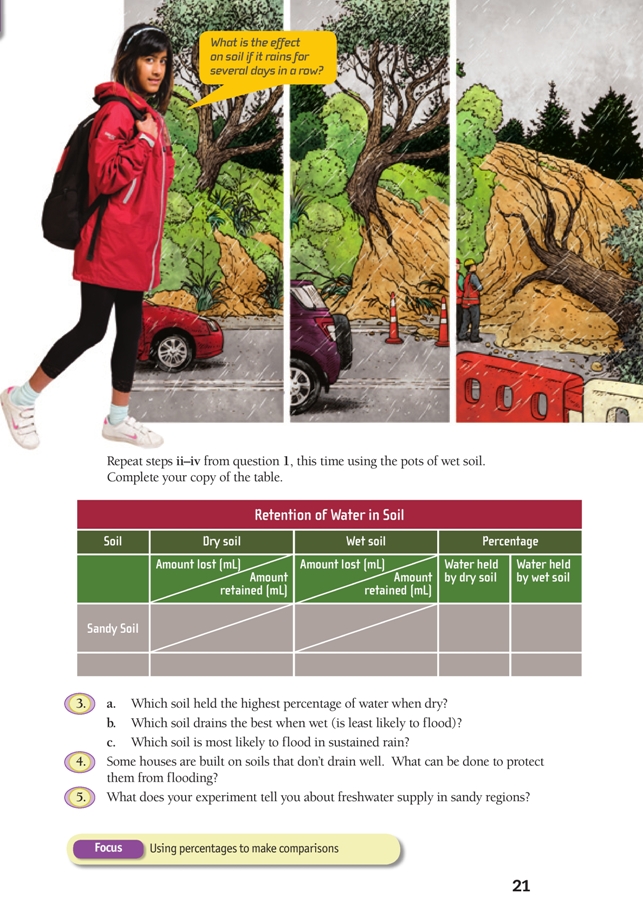This is a level (3+ to 4+) mathematics in science contexts activity from the Figure It Out series.
A PDF of the student activity is included.
Click on the image to enlarge it. Click again to close. Download PDF (1408 KB)
Students will:
- collect and accurately measure amounts of water
- calculate percentages for retention of water.
Students should discover that:
- rates of dry and saturated (wet) water retention are independent of each other.
water
a graduated kitchen jug or similar
a timer or stopwatch
4 types of soil
8 same-sized plastic plant pots (with holes)
results table (see copymaster)
classmates
FIO, Using Resources, Levels 3+-4+, Too Much Water, pages 20 - 21
Preparation and points to note
As this is an outside activity involving dirt and water, a level of mess is inevitable. Establish protocols designed to minimise mess and prevent “accidents” and horseplay.
Experiments should be structured so that students can draw meaningful results. Prompt the students to apply the results of their experiment. (This can be linked to reasoning in flexible ways, an aspect of the key competency thinking.)
Finding genuinely dry soil with high clay content is almost impossible because of its ability to retain water. This doesn’t matter, and nor does it matter if the other soils are somewhat damp to start with because it is only when they are saturated that the difference in carrying capacity becomes really marked. Note that, when damp, pure clay is virtually waterproof (so much so that it is sometimes used to line reservoirs).
Any same-sized plant pots (plastic or fired or unfired clay pots) can be used for this investigation as long as they have holes in the bottom. The students will need to stop the sand and fine soil disappearing through these without interfering with the drainage. A little scrunched-up newspaper works well. 2 litre ice cream containers with holes poked in the bottom could be used instead of pots. If the pots aren’t filled right to rim level, this allows water to pond on the surface of poor-draining soils.
The second part of the investigation uses the same pots and soil as the fi rst. There is a time lag (overnight) before the pots are ready for this second part.
Points of entry: Mathematics
Twice in this activity, the students pour a measured amount (1/2 litre, which is 500 mL) of water into each pot, wait until what can’t be absorbed has stopped dripping through the holes, measure the amount that has dripped through, and do some calculations using percentages. It is important that the students understand what the process is designed to find out rather than blindly follow a set of steps because they have been told to. Fundamentally, they are trying to compare what happens when rain falls on different types of dry ground with what happens when it falls on the same ground when saturated (following earlier rain). They do this by measuring the water-holding capacity of 4 soils in the 2 different states. By translating the amount dripped through into percentages, they can easily compare results for the different soils.
Ensure that the students understand that, in the end, they are interested in how much water has been retained by the soil, not how much has dripped through. This means that, for each pot, they need to measure the amount that has dripped through and subtract this from 500 mL (the amount poured in). They then convert this difference (the amount of water held) to a percentage. By comparing the 4 percentages for dry soil and the 4 percentages for the wet soil, they should be able to reach some conclusions about the water-retention properties of the different soils. You could ask them to find a way of representing their findings graphically.
Points of entry: Science
Like any scientific experiment, standardised procedures need to be established so that variables can be controlled, results compared, and conclusions reached. If doing this experiment as a whole-class activity, have the students work in small groups. Challenge them to identify the various variables (independent and dependent) and any problems they can see in controlling the independent variables. Can they suggest ways of managing these problems?
One variable that is difficult to control is volume of soil: how can the students ensure that each pot contains the same amount when soils compress differently? (Soil that is mostly gravel will compress very little; loam will compress quite a bit. A small piece of concrete or something similar could be used to apply standardised pressure to the different soils in the pots.) Ask the different groups to reach agreement on a common methodology so that their results can be compared.
Before they pour any water, ask each group to make and state a prediction (for example, “Gravel will drain best whether dry or wet.”). They can then test their hypothesis against the data.
The following is a set of hypothetical data:
Conclusions that might be drawn from the above “data”:
- Stony soil drains best overall (allows water to simply pass through it, no matter how wet it gets). When saturated, the sample held only 4% of the new water.
- Sandy soil holds the most water initially. (Water collects in the large spaces between the sand particles; sandy soil dries out quickly and never becomes waterlogged.) When saturated, 90% of the new water just passed through it.
- Potting mix struggles to absorb water when dry (it retained about 50%). It also drains fairly freely when saturated (it retained just 19% of new water). (This is a problem for plants in pots, as the minerals they need drain out with the water.)
- Clay soil absorbs water well initially. However, when saturated, the clay let very little of the new water through (just 5%). Soil like this would be very prone to flooding or to retaining surface water.
Answers
1.–2. Practical activity
3. Answers will vary.
a. The soil with the least amount of water dripped through when dry (probably a clay soil)
b. The soil with the greatest amount of water dripped through when wet (probably a sandy soil)
c. The soil with the least amount of water dripped through when wet is most likely to flood. For example, a clay soil doesn’t let much water through (or even none), so water will tend to collect on the surface and flood.
4. If houses are built on a type of soil that drains poorly, extra drains need to be installed. If a house is to be built on very badly draining soil, large-capacity stormwater drainage should be installed and/or the house should be built on raised foundations.
5. Your experiment will have shown you that sand retains water initially (because of the large spaces between the sand particles) but that once saturated, most of the water passes through it. Sandy regions tend to have little natural groundwater or year-round sources of fresh water. In other regions with different soils, water that passes through topsoil collects in the subsoil or lower layers or flows into streams and rivers.


